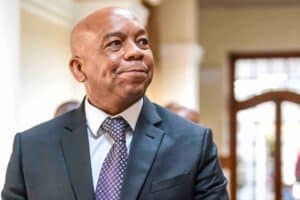Eskom argued that Nersa’s decision to disallow the equivalent of the government bailout of R69 million for the three financial years was unjustifiable and irrational.

The unprecedented face-off between Eskom and the energy regulator continued at the Pretoria High Court on Monday – this time over the regulator’s 2018/2019 tariff decision.
This is the second matter against the National Energy Regulator of South Africa (Nersa) that has been heard by Judge Jody Kollapen this month. Eskom is trying to challenge some of Nersa’s historical determinations, which it argues have not been cost-reflective, to a point of not only being devastating to Eskom’s finances but those of the country.
In a separate case two weeks ago, Eskom representative senior advocate Matthew Chaskalson argued that Nersa’s decision to disallow the equivalent of the government bailout of R69 million for the three financial years from 2019 to 2022 – and turn that into an “electricity tariff subsidy” in order to keep tariff increases low – was unjustifiable and irrational.
On Monday, Chaskalson continued his assault on the regulator, saying the single-year tariff determination for 2018/2019 – which ended with Eskom receiving a 5.23% increase as opposed to the 19.9% increase it had applied for – was “invalid”.
This resulted in Eskom receiving allowable revenue of R190 billion, which is R29 billion less than the R219 billion the utility wanted.
Reverse engineering
Chaskalson challenged the process Nersa used to determine the tariff, saying it did not comply with the Electricity Regulation Act, the Electricity Pricing Policy and Nersa’s own regulatory methodology used to determine electricity tariffs.
He said instead of considering what “allowable revenue for a reasonable licensee in the position of Eskom” would be and then working that price down through a process of deduction as the methodology dictates, Nersa conducted the process backwards.
“It seems clear that Nersa decided on the low tariff and then attempted to reverse engineer a justification for that tariff increase by finding artificial ways to disallow billions of rands in Eskom costs that ought to have served as the basis for the correctly-determined tariff increase,” said Chaskalson.
He outlined how, in the reasons for determination provided by Nersa, there was evidence that deductions across multiple areas such as Eskom’s coal spend, operational costs, asset base, transmission and independent power producer costs were made through subjective considerations, without justification and had a “series of patent arithmetical and double counting errors”.
Not only that, but Eskom states in court papers that “substantial” parts of the regulator’s reasoning show no link to the decision that was finally taken, which suggests to Eskom that these are “either remnant of a reasoning process in relation to a decision which was previously intended to be taken, or evidence of a decision that was not properly reasoned”.
Employee costs
In one instance when determining employee costs, Chaskalson said Nersa applied an “arbitrary” approach that stripped Eskom of R3.8 billion in revenue for employees by using a ratio of how many gigawatt hours (GWh) Eskom produces per employee compared with 2007/2008 as a base year.
The result shows that Eskom was able to produce 239 109 GWh with 32 954 employees in 2007/2008, compared with 216 771 GWh and 39 186 employees in 2018/2019 – a drop from 7.26 GWh to 5.3 GWh per employee over the 11 years – with Nersa reasoning that Eskom is overstaffed and should not be compensated for the full costs.
Chaskalson said Nersa’s reasoning was not only “wholly inappropriate” but was “reverse engineering of a desperate nature, designed to reduce allowable revenue”.
Chaskaslon said selecting 2007/2008 as the base year was inappropriate because that was the year that sales peaked prior to the global financial crisis and demand outstripped supply, therefore power stations were used well beyond their capacity to the extent that load shedding became necessary for the first time.
“If you choose the year in which your system is operating beyond ordinary industry parameters and you say this is the output that you want per GWh ratio to employees, then you are going to find that you get a higher ratio per employee; but it is not a sustainable basis [on which] to run an electricity generation business,” argued Chaskalson.
He accused Nersa of not considering what Eskom would require for its operational costs and instead “looking for some pretext to slash Eskom’s allowable revenue”.
Nersa will respond to Eskom’s arguments on Tuesday.
Brought to you by Moneyweb






